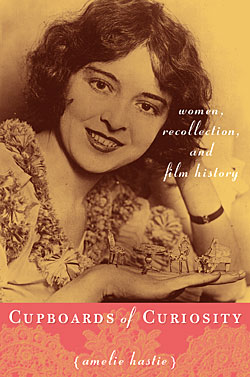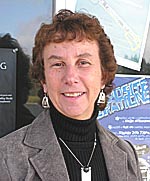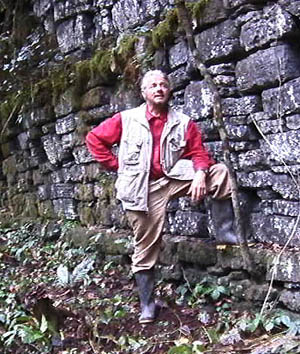  |
 |
|
|
|
||
Send us your news... Support the Arts Any Questions? © UC Santa Cruz |
|
 Cupboards of Curiosity |
Since last summer, Hastie also has been a member of the local radio station KUSP's “Film Gang.” For her part, Hastie records bi-weekly movie reviews in an aim to bridge the scholarly work at UCSC with the Santa Cruz community at large. “I see the programs as models for viewing rather than simply ‘reviews,’” she says.
In another effort toward “public intellectual” work, Hastie published a short essay called “After Taste” in the “Ingestions” column of the journal Cabinet (a quarterly magazine of art and culture). The essay is an autobiographical piece on her changing relation to candy after losing the sense of smell, following brain surgery.
Stamp delivers keynote address at conference
Film and digital media department chair Shelley Stamp delivered the keynote address at the 12th Annual Monterey County Women's Multicultural Conference in March. Her talk, "Women's Filmmaking: Looking Forward, Looking Back," was part of a day-long celebration of recent films by and about women that also included film screenings, panel discussions and visiting filmmakers.
Daniel, Hastie featured in innovative online journal
The work of film and digital media professors Sharon Daniel and Amelie Hastie was recently published in an innovative new online journal, Vectors: Journal of Culture and Technology in a Dynamic Vernacular.
Daniel's interactive piece, "Public Secrets," is available at http://www.vectorsjournal.org/index.php?page=6. The injustices of the criminal justice system and the prison industrial complex are public secrets — secrets that the public chooses to keep safe from itself, like “don't ask, don't tell.” “Public Secrets” provides an interactive interface to an audio archive of hundreds of statements made by current and former prisoners, which unmask the secret injustices of the war on drugs, the criminal justice system and the prison industrial complex. Visitors navigate a multi-vocal narrative that links individual testimony and public evidence, social theory and personal statements, in an effort to engage the public in a critical dialogue about crime and punishment and challenge the assumption that imprisonment provides a solution to social problems.
Hastie edited a special section of the "Ephemera" issue devoted to "The Object of Media Studies." Hastie’s project was based on a Humanities Research Institute group seminar that she convened at UC Irvine in 2005. The project is designed to allow multiple sensory and historical experiences of moving images to interact with one another through the visitor/reader's traversal of the screens. The project can be found at http://www.vectorsjournal.org/issues/03_issue/objectOfMediaStudies.
Vectors is an international peer-reviewed electronic journal dedicated to expanding the potentials of academic publication via emergent and transitional media. Vectors brings together visionary scholars with cutting-edge designers and technologists to propose a thorough rethinking of the dynamic relationship of form to content in academic research, focusing on the ways technology shapes, transforms and reconfigures social and cultural relations. The journal only publish works that exceed the boundaries of print.
History of Art and Visual Culture
González receives Wyeth Foundation art grant
History of art and visual culture associate professor Jennifer González has received a $16,000 publication grant from the Wyeth Foundation for American Art in suppport of her forthcoming book: Subject to Display: Restaging Race in Contemporary Installation Art (MIT Press). The grant is awarded through the College Art Association to support the publication of books on American art.
 Jennifer González |
González has written for periodicals such as Frieze, Diacritics, Inscriptions, Art Journal, and Bomb. She has also contributed chapters to The Encyclopedia of Aesthetics (1995), as well as books such as With Other Eyes: Looking at Race and Gender in Visual Culture (1999), Race in Cyberspace (2000), and Only Skin Deep: Changing Visions of the American Self (2005).
Miller awarded model grant from NEH
Music professor Leta Miller has received a $24,000 fellowship from the National Endowment for the Humanities (NEH) for a book project titled San Francisco's Musical Life, 1906-45. The award was designated as a We the People grant—a special recognition given by the NEH for model projects that advance the study, teaching, and understanding of American history and culture.
 Leta Miller Photo: Scott Rappaport |
Scheie nominated for two Bay Area theater awards
 Danny Scheie |
Scheie has previously earned four Bay Area Critics Circle awards and four Dean Goodman Awards, as well as GLAAD Media and Robby nominations for his work in Los Angeles. His career includes more than a dozen seasons with Shakespeare Santa Cruz, where he served as artistic director from 1992 to 1995.
UC Santa Cruz assistant arts dean reports discovery of ancient ruin in Peru
UC Santa Cruz assistant dean of the arts Keith Muscutt reported the existence of a previously unknown pre-Columbian ruin in Peru at the annual Institute of Andean Studies conference held at UC Berkeley in January.
 Keith Muscutt at the site of a newly discovered ruin in a remote area of Peru. |
Located in the remote and densely forested eastern slope of the Andes Mountains, the massive ruin is thought to be a remnant from Peru’s vanished Chachapoya people, who flourished in the upper Amazon region from the ninth to the 15th century. There is little evidence of the culture left today, except for the ruins of ancient settlements and well-preserved mummies recovered from cliff tombs.
The ruin was first discovered by three local Peruvians in August who relayed the information to Muscutt, an expert on the Chachapoya and author of the 1998 book Warriors of the Clouds: A Lost Civilization in the Upper Amazon of Peru (UNM Press). Muscutt traveled to Peru in late August to make a preliminary survey of the site, dubbed “Huaca La Penitenciaria” (The Penitentiary) because of its formidable appearance.
The site consists of a large ceremonial platform overlooking a plaza and numerous rectangular and circular buildings, situated in an area that has been covered by forest for centuries. Muscutt noted that it is of particular interest because of its size, distinct design, and remote location.
“This is an exciting development for Chachapoya archaeology,” said Muscutt. “With the exception of the colossal retaining wall of the Chachapoya citadel, Kuelap, I can’t think of a Chachapoya engineering project as ambitious as La Penitenciaria. Over 25,000 cubic yards of dressed stone and rubble were needed to build it....It promises to open a new chapter in the history of the Chachapoya.”
Muscutt said that he is currently working with GRB-TV and the Discovery Channel to plan a full-scale archaeological investigation of the newly discovered site. He added that the ruin will be featured in a Discovery Channel documentary series to be aired next year.
Muscutt has been exploring the Chachapoya’s ancient home in the remote upper Amazon region of Peru for the past three decades. In 2001, he was featured in a History Channel program titled Cliff Mummies of the Andes.
Henry named Arts development director, Gibb takes reins of SSC development
Matt Henry has been promoted to Arts development director. Henry, who was the director of development for Shakespeare Santa Cruz since May 2004, previously was an assistant director of the Annual Fund and Student Affairs at UCSC.
Ann Gibb is the new Shakespeare Santa Cruz director of development. Gibb, who most recently was the development writer for the Physical and Biological Sciences Division, had also served as a member of the Shakespeare Santa Cruz Board of Directors since October 2005. She resigned from the SSC Board when she began her new position in February.
Ann McCrow, who served as the Arts development director prior to Henry, has been tapped as the UCSC Foundation director. In this role, she is responsible for the overall administration of the UCSC Foundation Board's activities and goals.